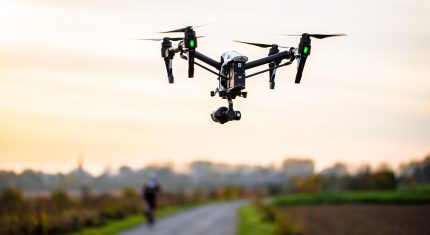
Swarm robotics can provide an agile way to gather large amounts of environmental data and coordinate operations of multiple devices. The U.S. military has been a key backer.
Swarm robotics is a new frontier for automation. It combines physical robots, drones, and sensors with non-physical controls, networks, and data. Swarm robotics revolutionizes how robots can function and, equally important, what kind of value they create.
In addition, swarming devices are not limited to the factory floor or ocean surface. They can be used in precision agriculture, to guide self-driving cars, and to execute tasks in combat situations. In the U.S., swarm robotics is taking off in two key areas: the military and academia. Let’s begin by examining the military role.
Military research into swarm robotics
Back in 2015, the Center for New American Security (CNAS), a foreign policy and national security think tank, published a report titled “The Coming Swarm: The Quality of Quantity.”
The CNAS explained that the heightened “vulnerability” of assets to vessels and aircraft has prompted the U.S. military to invest “miniaturized” innovations such as “emerging robotic technologies” that can “fight as a swarm.” This is a huge business opportunity for companies that supply and integrate robots and unmanned systems in the defense industry.
Around the same time, the Strategic Capabilities Office, a “discreet” Pentagon division, tested “micro-drones.” These 3D-printed unmanned aerial vehicles (UAVs) were launched from a canister and were instructed to find one another in the air.
In addition, the Defense Advanced Research Projects Agency (DARPA) approved the development of drones called “Gremlins,” named after the creatures British pilots viewed as good luck charms during WWII.
DARPA tapped four companies to develop those UAVs: Composite Engineering, Dynetics, General Atomics Aeronautical Systems, and Lockheed Martin. The Gremlins were designed to be reused up to 20 times. Lockheed Martin has developed controls for swarming robotics.
Weaponizing autonomy
The U.S. Department of Defense’s 2017 budget request included $71.4 billion for research and development. The second technology that U.S. Defense Secretary Ashton Carter cited (after smart bombs) was “swarm autonomous vehicles,” including “micro-drones.”
The Pentagon has also stirred controversy by approving the development of autonomous military robots.
DARPA is developing a way for “weaponized drones” to work with one another and complete tasks with little human input. The “Collaborative Operations in a Denied Environment (CODE)” program was intended to enable UAVs to act autonomously, especially in situations when capabilities such as GPS would be offline.
Ironically, even as DARPA develops swarm robotics for offensive purposes, it is also looking to develop systems to protect against foreign swarms.
In August 2016, DARPA put out a request for information to develop “Mobile Force Protection.” It wants this hardware to be functioning by 2020 and for it to have “upgradeable” components.
Military swarm robotics are also getting smaller,
As the U.S. develops swarm robotics and countermeasures, the question arises of where in the world they will be deployed and sold, as well as how this technology might proliferate among its allies and rivals. There are also non-state threats such as criminals.
Testing the waters
Multiple navies around the world are testing swarm robotics, combining intelligence gathered by aerial drones and surface and underwater systems (and amphibious ones).
The U.S. Navy’s Office of Naval Research (ONR) has a strategy called “Low-Cost UAV Swarming Technology (LOCUST).” It tested LOCUST in early 2016, shooting nine drones into the air and capturing the entire trial on video.
Swarm robotics in space
The National Aeronautics and Space Administration is also involved in swarm robotics. NASA once developed “Swarmies” to fuel space mining missions. These robots were based on the movements and behavior of ants. NASA started with four robots, but it planned to scale and integrate RASSOR, a digging robot.
RoboBusiness 2018 hosts four distinct conferences within one global umbrella event. This unique format delivers a customizable in-depth educational, technical, and business intelligence experience for the entire robotics ecosystem. Our 2018 event offers the following conference offerings:
- Robo Tech Trend Forum
- RBR Executive Summit
- Robotic Design and Engineering Forum
- CRO Summit
The U.S. government’s interest in swarm robotics, from DARPA and the Navy to NASA, should not be surprising. It follows the Pentagon’s “Third Offset Strategy,” a military doctrine that seeks to integrate emerging technologies to fill gaps and vulnerabilities. The strategy explicitly mentions using robots, autonomous systems, advanced manufacturing, and more.
If the U.S. military supports the development of swarm robotics, other countries are bound to follow its lead. Such technologies no longer require big, expensive deployments. Users are looking for swarm robotics to provide capabilities that are lean, versatile, and autonomous.
In our next article, we’ll look at how academia in the U.S. is also supporting swarm robotics.
roboticsbusinessnews.com